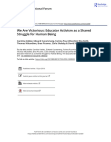
We Are Victorious: Educator Activism as a Shared Struggle for Human Being
by Farima Pour-Khorshid, Ph.D., Carla Shalaby, Carolina Valdez, Thomas Nikundiwe, Rita Kohli, Bree Picower, and Edward Curammeng
This article shares national models of educational activism that center the experiences of People of Color but are diverse in that they serve students, parents, preservice teachers, teachers, and/or community educators and meet frequently in small groups or annually/biannually. Included narratives embody the humanization process, and situate that in the purpose of each project. Our aim is to complicate and extend the definition of activism as a shared struggle for the right to feel human.
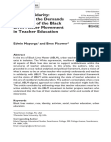
Active Solidarity: Centering the Demands and Vision of the Black Lives Matter Movement in Teacher Education
In the era of Black Lives Matter (#BLM), urban teacher education does not exist in isolation. The White supremacist, neoliberal context that impacts all aspects of Black lives also serves to support antiblackness within the structures of teacher education. In this article, the authors, who are grounded in a race radical analytical and political framework, share a vision of what it means to be an urban teacher who actively understands and teaches in solidarity with #BLM. The authors unpack their theoretical framework and the vision of #BLM while examining the state of teacher education in this era of neoliberal multiculturalism. The authors contemplate what a race radical, #BLM-aligned, approach to urban teacher education might look like. The article concludes by addressing ways that teacher educators must be in active solidarity with the #BLM movement to better prepare teachers who understand that the lives of their students matter within and outside of their classrooms.
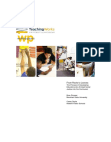
From Roots to Leaves: The Process of Developing Educators who Embed Social Justice into the Curriculum
by Bree Picower and Casey Doyle
In this article, Picower and Doyle move the discussion about social justice education from the theoretical to the practical by examining how critical social issues can be integrated into the design and sequencing of lessons. Aspiring and new teachers often have a desire to engage students in issues of social justice but find themselves overwhelmed when presented with scripted curriculum, high stakes test prep, and mentors without the drive or experience of doing it themselves. This paper provides support by showing concrete points of integration between traditional curriculum design and critical social justice content. Picower, a teacher educator, illustrates how she prepares new teachers with this skill set, and Doyle, a new teacher and former student of Picower’s, showcases a unit that she implemented about poisoned water in her urban school district.
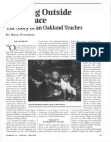
Teaching Outside One’s Race
I am writing this paper in order to reflect on my experiences at Prescott Elementary School. Here, I discuss the aspects of the school that are unique: the culturally relevant pedagogy, the other teachers on the staff including Carrie Secret, the professional development at the school, the Ebonics debate, and, finally, racial identity development and how it informed relationships at the school. A goal of this paper is to contextualize what was really being done in Oakland schools in contrast to what the media reported as teaching Ebonics.’ I also hope to show the importance of successful mentor teachers of color in the development of new teachers at a mission driven school.
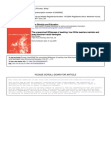
The unexamined Whiteness of teaching: how White teachers maintain and enact dominant racial ideologies
While much research that explores the role of race in education focuses on children of color, this article explores an aspect of the predominately White teaching force that educates them. This article explores findings from a qualitative study that posed questions about the ways in which White pre-service teachers’ life experiences influenced understandings of race and difference, and how these preservice teachers negotiated the challenges a critical multicultural education course offered those beliefs. In keeping with the tenet of critical race theory that racism is an inherent and normalized aspect of American society, the author found that through previous life-experiences, the participants gained hegemonic understandings about race and difference. Participants responded to challenges to these understandings by relying on a set of ‘tools of Whiteness’ designed to protect and maintain dominant and stereotypical understandings of race – tools that were emotional, ideological, and performative. This phenomenon is typically referred to as resistance in the literature on White teachers and multicultural education. The author contends, however, that these tools are not simply a passive resistance to but much more of an active protection of the incoming hegemonic stories and White supremacy and therefore require analysis to better understand when and how these tools are strategically used. Understanding how these tools of Whiteness protect dominant and stereotypical understandings of race can advise teacher education programs how to better organize to transform the ideologies of White teachers.
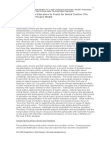
Supporting New Educators to Teach for Social Justice: The Critical Inquiry Project Model
Urban public schools and their teachers are under siege. From increased standardization, privatization and testing to a growing number of students whose needs are not being met by schools, urban public school teachers face a daunting task. Without a space in which to critically examine their daily experiences within schools, many well-intentioned teachers find themselves unwittingly reproducing existing social inequities. The Social Justice Critical Inquiry Project (CIP) at New York University was a two-year program piloted to create a space to support preservice teachers as they transition into their first year of teaching in New York City public schools. This group allowed participants to reflect on their experiences and share their apprehensions, struggles and excitement about teaching with equity centered in their classrooms. Participants used the lens of social justice, applying the frameworks of equity, agency, cultural relevance and critical literacy (Lipman, 2004), to their practice in order to improve the educational experiences and achievement of their students. The following article provides details about the project’s goals, activities, outcomes, challenges and its implications for teacher education.

Resisting Compliance: Learning to Teach for Social Justice in a Neoliberal Context
Background/Context: This study examines education in the context of neoliberalism and how current educational policies such as high-stakes testing and mandated curriculum create schooling environments hostile to social justice education. Relying on education for liberation literature, teacher education for social justice scholarship, and work on critical pedagogy, this study explores how new teachers who teach from a social justice perspective navigate the challenges of their first year in teaching. This study asks, What strategies do new teachers use to stay true to their vision of teaching for social justice despite the challenges they face in their school environments? The participants were all members of a social justice critical inquiry project (CIP) group that met at the university from which they graduated. The teachers developed four strategies for teaching for social justice. First, by participating in a critical inquiry project, the teachers supported each other by building a safe haven that protected their vision. Second, the participants camouflaged their critical pedagogy by integrating it with the mandated curriculum, which allowed them to teach from a social justice perspective without rousing the concerns of their administration. The third strategy was to develop their students as agents of change. Finally, in a few instances, the teachers went public with their work by rejecting or speaking against policies that they felt were not in the best interests of their students. Conclusions/Recommendations: Although these four strategies allowed participants to successfully create critical classrooms, they did not impact the larger neoliberal forces that maintain unjust schooling experiences. This has implications for teacher education, and the author suggests recommendations for schools of education.
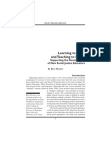
Learning to Teach and Teaching to Learn: Supporting the Development of New Social Justice Educators
Beginning teachers are more likely to leave the profession than seasoned counterparts; 14 percent of new teachers leave after their first year, 33 percent leave within three years, and almost 50 percent leave in five years (Alliance for Quality Education, 2004). Research on teacher attrition shows many educators who are part of this “revolving door” (Ingersoll, 2001) are “service oriented” and “idealistic” teachers (Miech & Elder, 1996). This study explored the role that participating in a critical inquiry project (CIP) played on the development of new educators who aspire to teach from a social justice perspective. The study also examined how relationships between the first- and second-year teacher participants shaped their development as social justice educators, learners, and leaders. Findings contribute to understanding two areas: new teacher induction and peer and near-peer mentorship. Unlike most new teacher support groups, CIP was specifically geared to support teachers in their pursuit of SJE. It provided induction designed to combat the attrition of “idealistic” teachers, a group often not targeted through professional development literature.
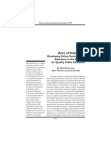
Acts of Solidarity: Developing Urban Social Justice Educators in the Struggle for Quality Public Education
In many instances, teacher education programs
have been positioned as apolitical entities with the task of preparing teachers to perform the duties and responsibilities of the profession. Instead, the position of the authors is that because teaching is a deeply political endeavor that requires expert knowledge of issues beyond the classroom, teacher education programs must embrace a particular responsibility. By taking the position that teaching for social justice is an act of necessity and solidarity, this work seeks to highlight two examples of teacher education initiatives. We begin with a working definition of social justice in education.
Following this section is a brief section linking the contexts of teacher education for social justice in Chicago and New York City. The third section (titled Part One) is a narrative example of building school and community relationships in Chicago, outlining the process by which a teacher educator engaged a school and the surrounding community as well as a an example of a collaborative teacher designed assessment tool for preservice teachers. The fourth section of the document (titled Part Two) discusses the New York context, providing an example of what building solidarity with student and community looks like at the classroom level. Concluding the document is a discussion of the importance of social justice in teacher education education in a day and age where local, state, and national conversations are dominated by the rhetoric of market economy and standardization.

Tools of inaction: the impasse between teaching social issues and creating social change
Within the field of teacher education, increased emphasis has been placed on social justice education (SJE). This qualitative study examined a group of beginning teachers who voluntarily participated in a social justice critical inquiry project (CIP). The findings indicate that while many of them were successful at teaching social issues, they provided few to no opportunities for their students to engage in social action and they themselves did not participate in activism. To explain this, the participants used the following four tools of inaction: tools of substitution, postponement, displacement, and dismissal. These tools relieved the tension of not taking action and allowed the participants to postpone, justify, or redirect the responsibility of becoming active in struggling for sustainable social change. Understanding the use of these tools can help teacher educators to understand the process of development of social justice educators.Within the field of teacher education, increased emphasis has been placed on social justice education (SJE). This qualitative study examined a group of beginning teachers who voluntarily participated in a social justice critical inquiry project (CIP). The findings indicate that while many of them were successful at teaching social issues, they provided few to no opportunities for their students to engage in social action and they themselves did not participate in activism. To explain this, the participants used the following four tools of inaction: tools of substitution, postponement, displacement, and dismissal. These tools relieved the tension of not taking action and allowed the participants to postpone, justify, or redirect the responsibility of becoming active in struggling for sustainable social change. Understanding the use of these tools can help teacher educators to understand the process of development of social justice educators.

Using Their Words: Six Elements of Social Justice Curriculum Design for the Elementary Classroom
This article provides a framework of six elements of social justice curriculum design for elementary classrooms. The elements move from students learning self-love and knowledge about who they are and where they come from to learning respect for people different from themselves. Students explore social injustice, learn about social movements, raise awareness, and engage in activism. By addressing all six elements, students develop an analysis of oppression and tools to take action. The elements help teachers visualize social justice education by providing examples of projects, making social justice in K-6 settings accessible, practical, and achievable.

Teacher Activism: Enacting a Vision for Social Justice
This qualitative study focused on educators who participated in grassroots social justice groups to explore the role teacher activism can play in the struggle for educational justice. Findings show teacher activists made three overarching commitments: to reconcile their vision for justice with the realities of injustice around them; to work within their classrooms to create liberatory space; and to work collectively against oppression as activists. To enact these commitments, they engaged in particular practices common across the teachers despite their years in the classroom or their geographic location.
A framework of teacher activism is revealed through the commitments and practices of the teacher activists, which can help support other teachers who are interested in working toward equity and justice in their classrooms and in the streets.

Education should be free! Occupy the DOE!: teacher activists involved in the Occupy Wall Street movement
Mass discontent erupted in 2011 through the Occupy Wall Street movement (OWS) when people took to the streets expressing frustration with growing economic disparities under neoliberal policies. In this article, I document how grassroots activists in New York City used OWS to galvanize energy for educational justice. Calling themselves Occupy the Department of Education, these teacher activists (TAs) critically analyzed wealth and power stratification as well as corporate-driven, market-based education reform. Through interviews, I explore TAs’ frustration with policies undermining the participation; voices; and power of parents, students, and educators and detail grassroots organizing strategies used to respond to neoliberal reform. These five strategies included unmasking the neoliberal narrative of meritocracy and choice; diverting discontent with the economic crisis toward educational justice; amplifying voices through tools that allowed for democratic participation of people silenced by current structures; claiming coalition among diverse groups rather than embracing competitive models; and generating power by organizing for change. Ultimately, I reveal that by using such strategies, TAs worked to build a movement to confront neoliberal school reforms that they saw undermining public education.
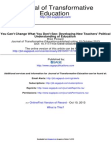
You Can’t Change What You Don’t See: Developing New Teachers’ Political Understanding of Education
Many teachers who enter the profession to ‘‘make a difference’’ do not realize education is a highly political field. This qualitative study examined how teacher education can support new teachers to develop a critical sociopolitical analysis of education. The findings indicate through a year-long course of study, teachers developed two new awarenesses about education. They (1) recognized that everything within education was political and because of this they (2) realized that they had more to learn. The overarching awareness about the political nature of education supported them to recognize four connected insights: (1) certain groups benefit from current structures while (2) others are oppressed, (3) parents and community members should have power in educational decisions that affect them, and (4) race plays a systemic role in all of the above.Within the awareness of realizing they had more to learn, three new stances emerged. Teachers started to (1) reexamine their prior knowledge, (2) realize they needed to hear multiple perspectives before forming opinions, and (3) analyze the political motivation of people providing information. By recognizing that everything is political and by taking a questioning stance, the findings indicate that the teachers reframed their analysis in five key ways. Teachers (1) moved from a focus on individual blame to a focus on systemic inequality; (2) from an ethnocentric perspective to culturally relevant pedagogy; (3) from viewing teachers as holders of power to facilitators who share power; (4) from seeing community deficits to seeing strengths; (5) and from feeling isolated to feeling connected.
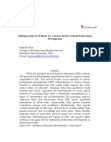
Nothing About Us Without Us: Teacher-driven Critical Professional Development
While the literature on social justice education (SJE) is robust, few professional development opportunities exist to support teachers committed to SJE. This article focuses on an example of critical professional development (CPD) called Inquiry to Action Groups (ItAGs) to understand how this model might support the social justice needs of educators. Findings from this qualitative study indicate that ItAGs supported the development of social justice teachers by providing them with a community characterized by a sense of camaraderie and professionalism. By providing support, reflection time, and discussions about SJE, ItAGs benefitted participants in three ways. Emotionally, they gained renewed motivation, energy and confidence. Intellectually, they gained content knowledge on the topic of their ItAG. Professionally, they gained resources such as readings and lesson plans. These benefits supported them to push their practice inside and outside of their classrooms. Understanding the impact of CPD can support others
looking to fill gaps left by traditional professional development in the pursuit of SJE.

Kohli, R., Picower, B., Martinez, A. & Ortiz, N. (2015). Critical professional development: Centering the social justice needs of teachers. International Journal of Critical Pedagogy. 6(2)
by Bree Picower, Rita Kohli, and Natalia Ortiz
As a response to increasingly technocratic, top-down teacher professional development that we refer to as antidialogical professional development (APD), this article theorizes a model of critical professional development (CPD) where teachers are engaged as politically-aware individuals who have a stake in teaching and transforming society. Illuminating three US based case studies of CPD that emerged in response to the unmet needs of justice-oriented teachers—The People’s Education Movement, New York Collective of Radical Educators’ Inquiry to Action groups, and the Institute for Teachers of Color Committed to Racial Justice—this article uses Freire’s (1970) framework of dialogical action to analyze shared critical practices. In each independent case, teachers were engaged in a cooperative dialectical process, there was a strong emphasis on unity amongst participants around their social justice goals, the structure was organized through shared power between teachers and organizers, and teacher and student needs were centered using a practice of cultural synthesis. Reframing the possibilities of teacher professional development through this model of critical, dialogical practice, this article offers a critique of the banking methods and technical content traditionally used within APD, and provides insights into how teachers can successfully be positioned as experts in their own social justice-oriented professional growth.